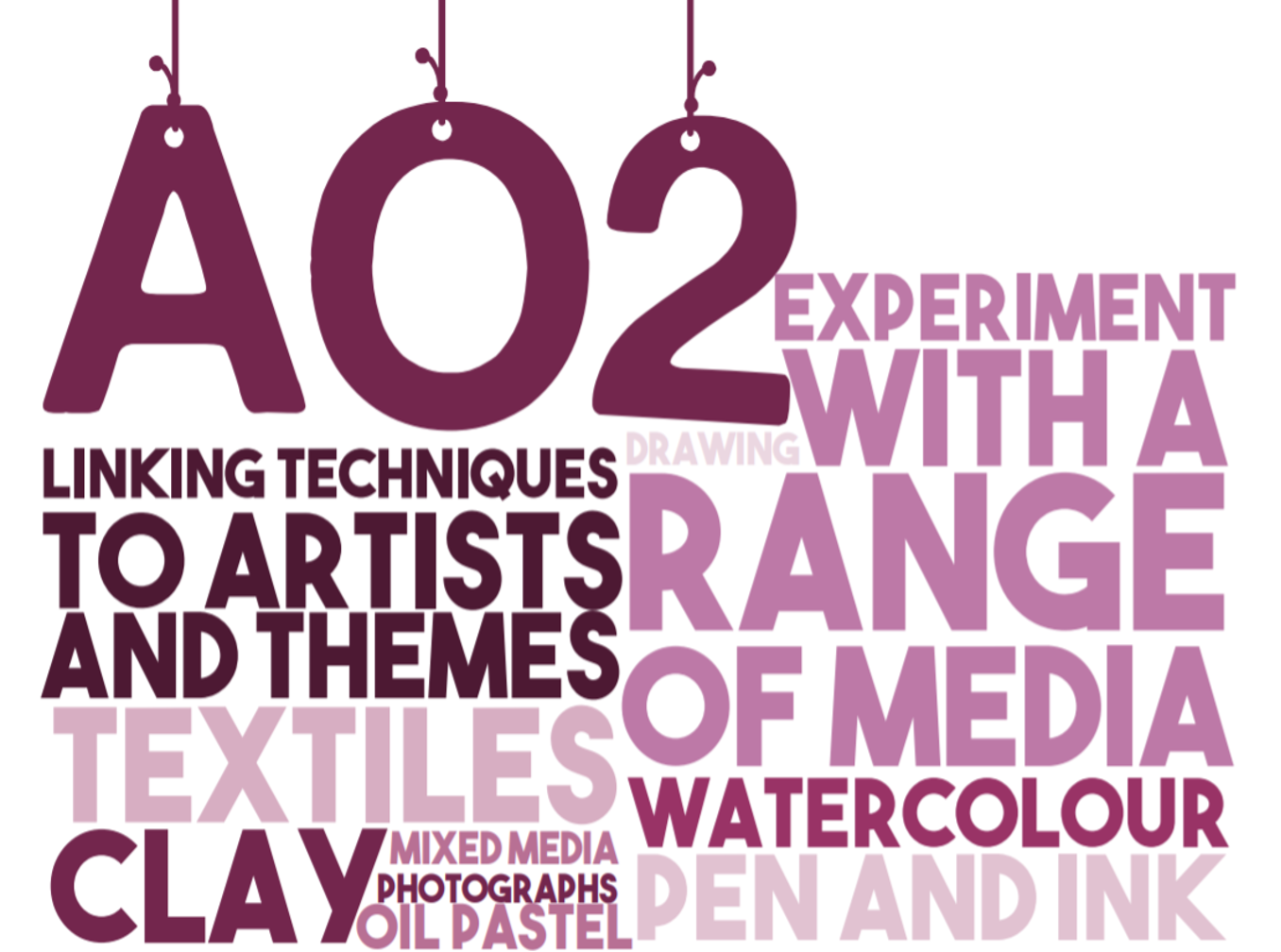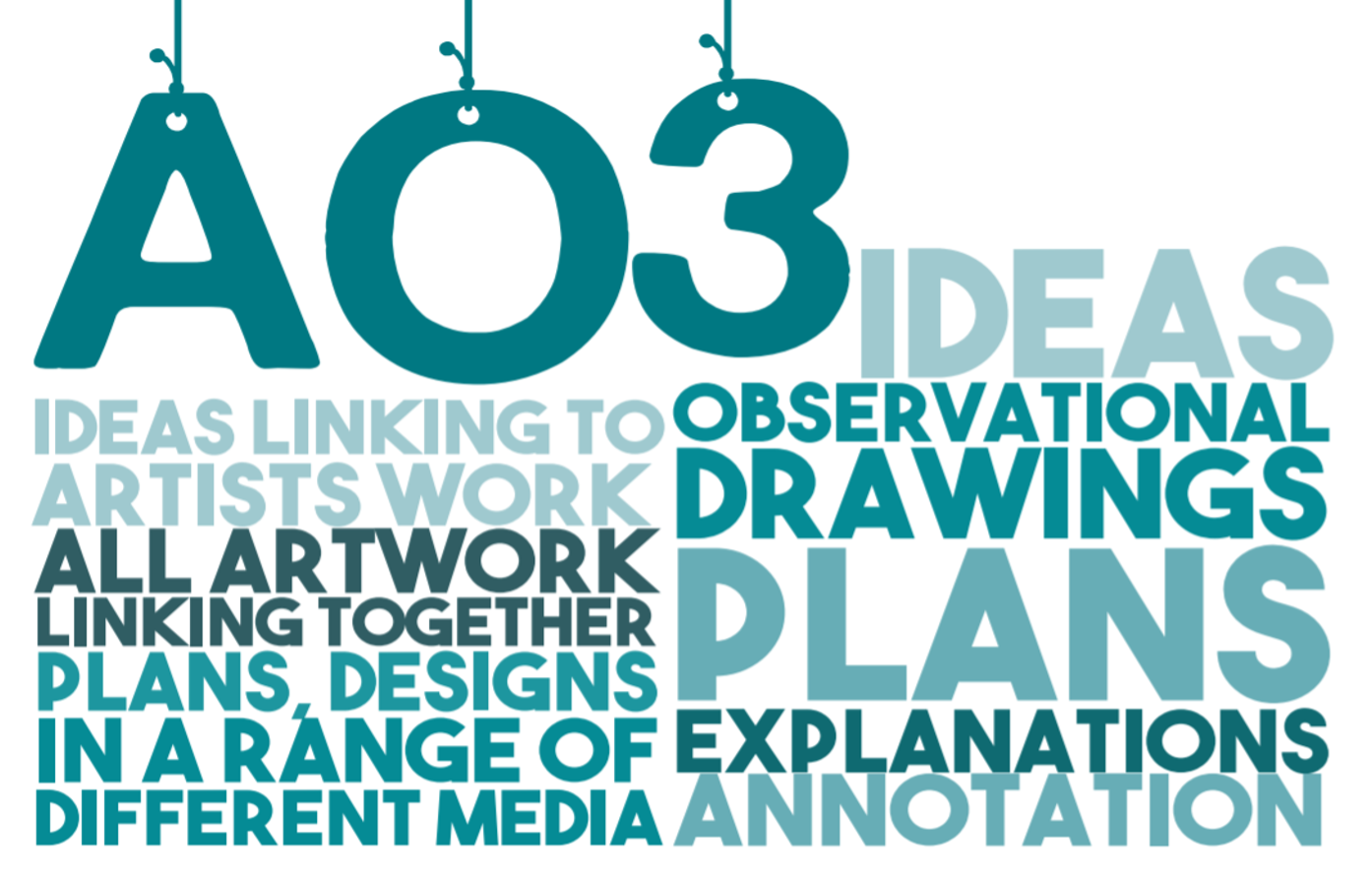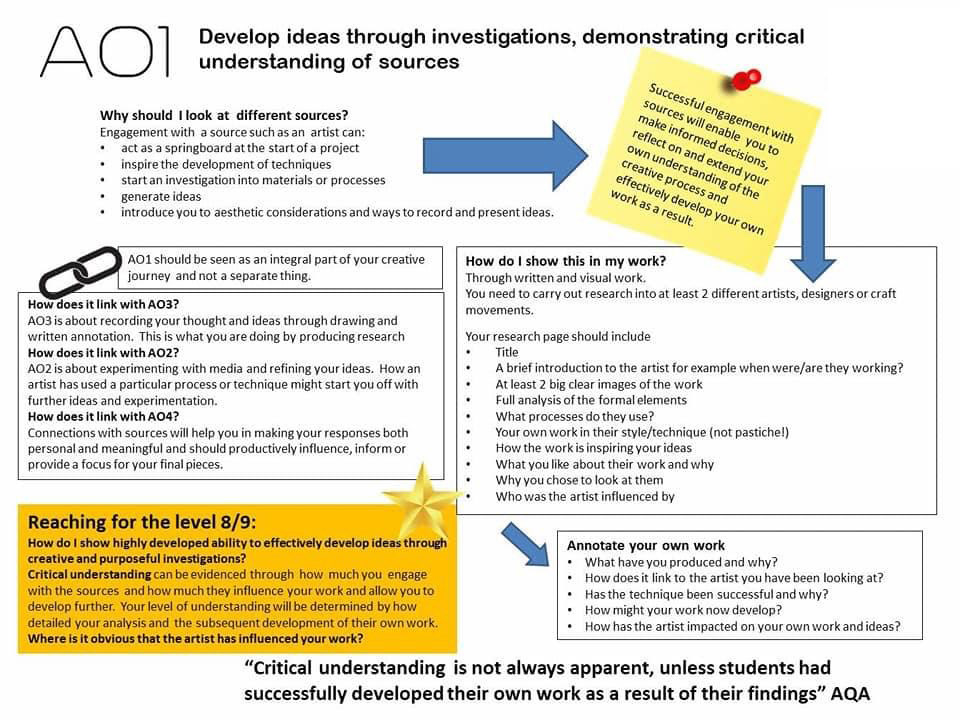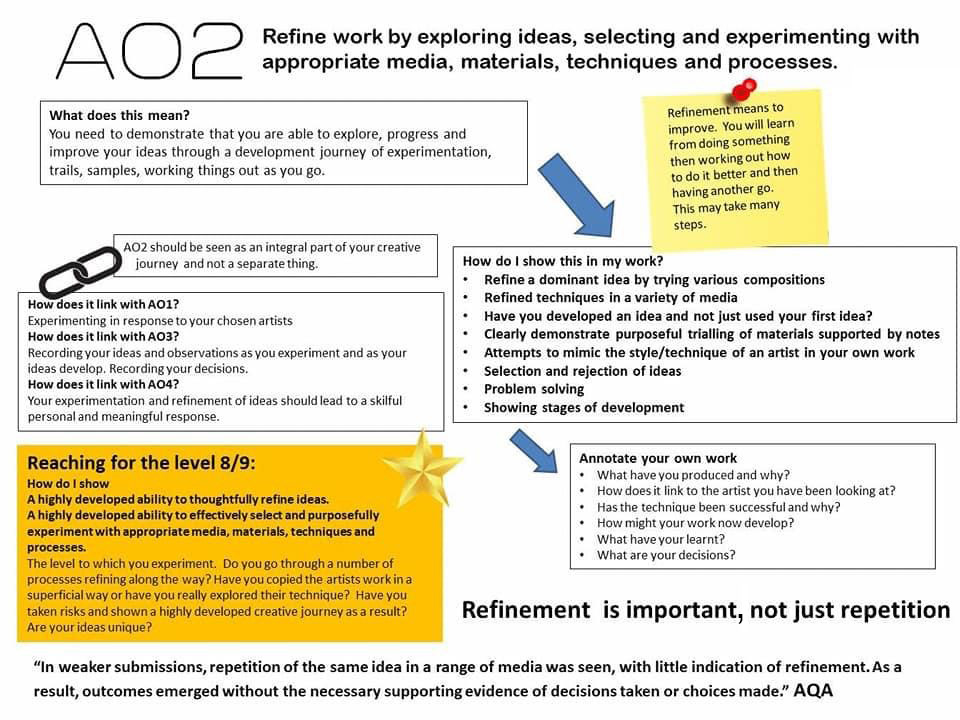How will my work be assessed?
The GCSE Fine Art course follows AQA's assessment criteria. To understand how your work will be assessed at the end of Year 11, you will need to be aware of the following...
The Assessment Objectives
There are four assessment objectives (AOs) you will be measured against, each counting for 25% of your overall mark for each project. Ofqual sets assessment objectives and are the same across all GCSE Art and Design specifications and all exam boards.




AO1: Develop ideas through investigations, demonstrating critical understanding of sources.
AO2: Refine work by exploring ideas, selecting and experimenting with appropriate media, materials, techniques and processes.
AO3: Record ideas, observations and insights relevant to intentions as work progresses.
AO4: Present a personal and meaningful response that realises intentions and demonstrates understanding of visual language.




Unpicking AO2:
There's more to Assessment Objective 2 (AO2) than simply getting experimental. Follow the PowerPoint below to understand better what it means, and gain ideas for how you can achieve it successfully.
What's my level of ability?
Even though you can't work out your grade before it gets marked at the end of the course, you can see roughly where you're heading by reading through the descriptions below and considering which level most closely reflects your projects.
Minimal ability - typically a grade 1
• Little evidence of idea development
• Ideas show little development
• A lot of direction by the teacher
• A short journey of experimentation
• Mainly copying of images
• Little connection with artists or other sources
• Little evidence of visual literacy/awareness/understanding/skills
• Lacking a sense of purpose
• Unclear what the student's intentions are
• Ideas show little development
• A lot of direction by the teacher
• A short journey of experimentation
• Mainly copying of images
• Little connection with artists or other sources
• Little evidence of visual literacy/awareness/understanding/skills
• Lacking a sense of purpose
• Unclear what the student's intentions are
Some ability - typically a grade 2 or 3
• Simple and basic understanding, evidenced in the use of visual language
• Beginnings of a sense of purpose
• Reflections on ideas, techniques and processes
• Initial signs of understanding and purpose in terms of developing ideas from artists or other sources
• Progress is reliant on the teacher's direction as it develops
• Simple, uncomplicated recording of observations and ideas
• Beginnings of a sense of intention in experimental pieces
• Briefor limited links between artists/sources and the student's own ideas
• An attempt to control the use of materials, techniques and processes
• Beginnings of a sense of purpose
• Reflections on ideas, techniques and processes
• Initial signs of understanding and purpose in terms of developing ideas from artists or other sources
• Progress is reliant on the teacher's direction as it develops
• Simple, uncomplicated recording of observations and ideas
• Beginnings of a sense of intention in experimental pieces
• Briefor limited links between artists/sources and the student's own ideas
• An attempt to control the use of materials, techniques and processes
Moderate ability - typically a grade 3 or 4
• Working towards a sense of purpose, a focus and an intention
• Inconsistent
• A short journey that is quite obvious and 'safe'
• Teacher-led and repetitive
• Shallow understanding
• Superficial analysis of artists or sources
• Variable depth of analysis, understanding, exploration, refinement and coherence
• Emerging/growing visual literacy and awareness
• Independence
• Understanding and maturity of skills
• Evidence needs to demonstrate greater depth of understanding
• Inconsistent
• A short journey that is quite obvious and 'safe'
• Teacher-led and repetitive
• Shallow understanding
• Superficial analysis of artists or sources
• Variable depth of analysis, understanding, exploration, refinement and coherence
• Emerging/growing visual literacy and awareness
• Independence
• Understanding and maturity of skills
• Evidence needs to demonstrate greater depth of understanding
Consistent ability - typically a grade 5 or 6
• Increasingly purposeful levels of selection and discrimination throughout the journey
• Understanding and using the results of experimentation on the development of ideas
• An increasing depth of understanding and analysis
• Refinement is informed, reflective and considered
• Exploring an appropriate and relevant variety of artists or sources
• Increasing confidence to take informed risks with experimentation and exploration of ideas
• Evidence of the development of ideas being less about copying other artists and more independent
• Combination of information and ideas resulting from exploration, reflection and refinement
• Recognising the value of artists/sources while developing ideas and using materials and techniques
• Decisions made that demonstrate increasing levels of intention, selection and discrimination
• Understanding and using the results of experimentation on the development of ideas
• An increasing depth of understanding and analysis
• Refinement is informed, reflective and considered
• Exploring an appropriate and relevant variety of artists or sources
• Increasing confidence to take informed risks with experimentation and exploration of ideas
• Evidence of the development of ideas being less about copying other artists and more independent
• Combination of information and ideas resulting from exploration, reflection and refinement
• Recognising the value of artists/sources while developing ideas and using materials and techniques
• Decisions made that demonstrate increasing levels of intention, selection and discrimination
Highly developed ability - typically a grade 7 or 8
• Assured, skilful and successful presentation of a personal response
• A depth of understanding, considered choice exploration and control of media
• Increasing levels of confidence and control in the way the student's ideas and artwork are integrated
• Use of experimentation and innovation to enhance the creative journey
• Well-informed and purposeful risk-taking
• Sustained and incisive reflection and consideration of choices
• Very good depth of understanding
• Informed intentions
• Independent and perceptive
• Growing maturity and clarity of purpose
• Very confident and insightful
• Discrimination and informed selection driving the choice and use of materials, processes and techniques
• A depth of understanding, considered choice exploration and control of media
• Increasing levels of confidence and control in the way the student's ideas and artwork are integrated
• Use of experimentation and innovation to enhance the creative journey
• Well-informed and purposeful risk-taking
• Sustained and incisive reflection and consideration of choices
• Very good depth of understanding
• Informed intentions
• Independent and perceptive
• Growing maturity and clarity of purpose
• Very confident and insightful
• Discrimination and informed selection driving the choice and use of materials, processes and techniques
Exceptional ability - typically a grade 9
• A mature ability to synthesise ideas alongside the selection of appropriate media and materials
• A high degree of personal response
• Sophisticated ideas consistently and confidently demonstrating depth of understanding
• Highly discriminating and rigorous process of selection related to media and materials
• Maturity of thinking, analysis and confident application of findings
• Clear and well-informed intentions
• An ability to qualify decisions, compare, discuss and originate ideas and alternatives
• A genuine process of discovery, possibly involving a willingness to take risks
• A mature awareness of the significance of challenge and change
• An awareness of the need for subtle, measured, informed change
• Clarity and purpose demonstrated through self-awareness
• A strong sense of independent thought and reflection throughout the creative journey
• A high degree of personal response
• Sophisticated ideas consistently and confidently demonstrating depth of understanding
• Highly discriminating and rigorous process of selection related to media and materials
• Maturity of thinking, analysis and confident application of findings
• Clear and well-informed intentions
• An ability to qualify decisions, compare, discuss and originate ideas and alternatives
• A genuine process of discovery, possibly involving a willingness to take risks
• A mature awareness of the significance of challenge and change
• An awareness of the need for subtle, measured, informed change
• Clarity and purpose demonstrated through self-awareness
• A strong sense of independent thought and reflection throughout the creative journey
The Projects:
There are two components (projects) to the GCSE. The first is called the Portfolio unit and is comprised of two projects that are marked together. The second is called the Externally-Set Assignment:
Portfolio Unit
• Practice Project and any miscellaneous
pieces: due February of Year 10
• A Sustained Project: due December of Year 11
• No time limit
• 96 marks
• 60% of the GCSE (both projects marked together)
pieces: due February of Year 10
• A Sustained Project: due December of Year 11
• No time limit
• 96 marks
• 60% of the GCSE (both projects marked together)
Externally-Set Assignment
• Final project: due May of Year 11
• Preparatory period (from 2nd January)
• Followed by 10 hours of supervised time in May
• 96 marks
• 40% of the GCSE
• Preparatory period (from 2nd January)
• Followed by 10 hours of supervised time in May
• 96 marks
• 40% of the GCSE
Who will mark my work?
Each year, your teacher attends a course run by AQA, that familiarises them with the exam board's standards for assessment for that year. In short, they view examples of work from students of different abilities.
Provisional marking:
At the end of the GCSE course (in May of Year 11), your teacher will mark your work, using the knowledge they have gained from the standardisation course and the assessment resources below. This will form a provisional mark that will be submitted to AQA.
Internal moderation:
After your teacher has marked your work, another teacher in the school (e.g. from DT or textiles) will check their marks and look out for accidental errors.
External moderation:
A moderator from AQA will visit your school in June of Year 11 to ensure your teacher has applied the mark scheme correctly. This is to check the marks. It may result in some students' marks going up, down or remaining the same. If the moderator lowers your marks and you feel it was unjustified, you can apply for the work to be re-moderated. This would involve the whole class having their work re-moderated, not just you. Your teacher can advise on this process.
How are the marks awarded?
Your teacher will use the assessment grid below when allocating marks to your work.
There's no such thing as 'losing marks'. Everyone starts at 0 and as your teacher spots evidence to support each assessment objective, they will add marks until they can't justify adding any more. Therefore, if a drawing isn't as good as earlier work in the portfolio, it doesn't then lower your mark.
Spider Diagrams:
The following spider diagrams help to determine which level (mark band) your project is in:
Mark band characteristics:
Unpicking the assessment objectives:
The marking process:
Below are the steps your teacher will follow:
• Your teacher will look through each project in detail, marking them one at a time.
• To ensure marking is consistent within your class, they will place everyone's projects in rank order.
• They will take note of your strengths and evidence of the different ways you have met each assessment objective.
• They will refer to visual examples of work (provided by AQA) to compare the standard of your work with work completed by other students from the previous year.
• They will refer to the assessment grid, spider diagrams, mark band characteristics and 'unpicking the assessment objectives' documents above, alongside the visual examples from the previous year, to guide and confirm what level your project is at.
• Having determined which mark band your project is in, your teacher will then look closely at the wording on the assessment grid, alongside the standards set by AQA at the standardisation meeting, to decipher whether each assessment objective has been met 'just', 'adequately', 'clearly' or 'convincingly'. These words help them to narrow down your mark. For example, a project that 'just' evidences a consistent ability to develop ideas from artists/sources would achieve 13 marks for AO1, while a project that 'clearly' evidences a highly developed personal, meaningful and informed final response would achieve 19 marks for AO4.
• Much of your teacher's decision will be based on years of experience, reference to previous work at the school, as well as previous examples from AQA, not just the wording on the assessment grid alone.
Internal and External Moderation:
Once your teacher has decided on a mark, another teacher will check that it has been done fairly and in line with the process described above.
You will then receive your provisional raw marks, which will be out of 96 for each component. You will not receive a grade because your mark is subject to change by the moderator, as are the grade boundaries, which are decided by the exam board in August.
Your marks will be inputted into AQA's website, which will generate a sample for the moderation day. Only work selected in the sample is moderated, although Kingsley's classes are nearly always small enough for every project to be included in the sample.
An external moderator will visit your school in June to look through your work and check that the marks awarded are in line with national standards.
You will find out your final grade on results day in August.
The appeals process:
Your teacher will email your raw, provisional marks to you a few days before they are sent off to AQA.
When you receive your provisional mark from your teacher, it will hopefully be in line with (or higher than) your previous 'working at' grades. However, if you suspect a mistake has been made you can appeal. But before you do that you must speak with your teacher to see if things can be resolved before the appeals process is initiated.
Appeals must be requested in writing and must contain evidence that the work has not been marked correctly. All appeals must be made before the deadline set by your teacher. To gather evidence, you must look through the work with your teacher, which means arranging an appointment with them to view your work alongside the assessment grid above under supervision.
Once a request for an appeal has been made, the school will arrange for someone else to check that your teacher has followed the correct marking process and that your marks are in the correct rank order. This may be another teacher in the school who has not already been involved in the marking process or an art teacher from another school nearby.
The teacher who reviews your work in the case of an appeal will only offer recommendations to your teacher. If there is a disagreement the final decision is made by the head teacher.
Appropriate reasons for appeal:
• You have evidence to suggest an administrative error was made
• You have evidence to suggest the processes explained above has not been followed correctly.
• You have evidence to suggest the processes explained above has not been followed correctly.
Unacceptable reasons for appeal:
• You are disappointed you weren't awarded a higher mark
• You aren't happy with the quality of the teaching
• You think your teacher dislikes you
• You worked really hard and feel you deserved a higher grade
• You aren't happy with the quality of the teaching
• You think your teacher dislikes you
• You worked really hard and feel you deserved a higher grade
It's worth noting that your work will go through moderation after the appeals process, which will override all previous marks. Also, if your teacher does put your mark up, it runs the risk of your mark going out of tolerance during moderation, which could consequently lower your grade.
The moderator will check that the school's marks are in line with national standards and your teacher's mark is only provisional. The appeals process is for identifying schools that are not following the marking process correctly.